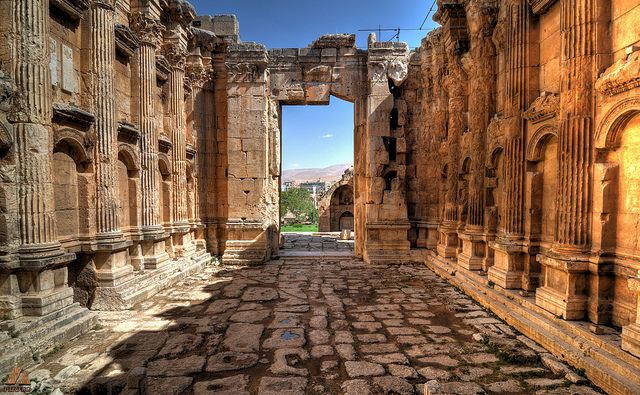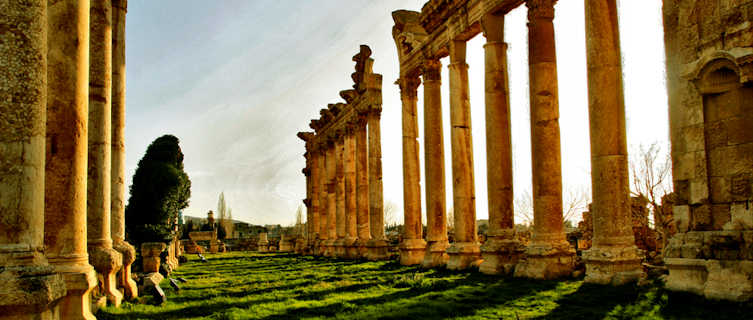

BAALBEC.
NORTH of Palestine is a hilly range, known as the Mountains of Lebanon. This range extends from a point about fifteen miles east of Sidon, in a north-easterly direction, nearly parallel with the shore of the Mediterranean Sea. Farther to the east, and parallel with Lebanon, runs the chain of Anti-Lebanon. Between these two ranges there lies a beautiful valley, about seven miles wide and seventy miles in length, which was anciently called Cule-(See-le) Syria, which means Hollow Syria, or Syrian Hollow. Down this valley flows the River Litany, sometimes called Leontes, whose waters empty into the Great Sea just north of Tyre. Tracing this river back until it becomes quite a small stream, and turning the eyes to the east, toward the heights of Anti-Lebanon, one sees in the far distance six huge columns, standing in a line, apparently surmounted by a large timber. If accompanied by a guide,
you will learn that these are a part of the ruins of the ancient city of Baalbee (JBAl' bee). You will hardly believe it, when the guide tells you they are five miles away; but after you have walked a mile or two in their direction, and seem to come no nearer to them, you conclude that he is right, and listen to his recital of the city's
history. A great many hundred years ago, large companies of men traveled on camels, bringing silks, spices, and much other merchandise from India to the sea-ports of Tyre and Sidon, whence they would be sent in ships to all parts of the world. These companies would wend their way down this valley, and when they came to the cool springs and beautiful shade trees that we see around us, they would unload their camels, and pitch their tents for a day's rest from their journey. When the people living in this part of the valley found that the merchantmen stopped very often, and would give their wares in exchange for fruits, vegetables, and grains, ‘they began to build stores and houses on the spot.'
In this way a large and wealthy city soon sprang up, and because the people worshiped the sun for their principal god, their city came to bear the name Baalbec, which means the "city
of the sun."
The inhabitants finally became so wealthy that they built magnificent palaces for themselves, and two vast temples in honor of their heathen gods. These, with sparkling fountains, stately monuments, delightful shade trees, and the fresh mountain breezes blowing over all, made the city so attractive that a great many traveled long distances to visit it, and the Grecian shearing of it, came over and captured it, and changed its name to the Greek word, Heliopolis, which means the same as the Syrian word, Baalbec.
It afterward passed into the hands of the Romans. By this time the idolatrous inhabitants had become very wicked, and even the Roman emperor put a stop to some of their sinful practices.
From this time the prosperity of the city declined, until in the year
1400 A. D. it was wholly overthrown.
All that now remains of this once magnificent city are the ruins of its temples and city walls; and the inhabitants, instead of living in palaces of hewn stone, make their homes in huts built of mud, and only number about two thousand. Though now lying in ruins, travelers love still to visit the spot; and as they stand among its fallen columns, and heaps of finely chiseled blocks, lying so useless at their feet, and see what wars, earth quakes, and the lapse of time, have done to these stupendous work of man, they acknowledge that the confused mass gives evidence of the "wrath of God against all ungodliness and unrighteousness of men." Some have thought that Baalbec was the "house of the forest of Lebanon," which Solomon built (1 Kings 7:2), but there is no proof that they are right.
But we have now come within full view of the ruins. Before us appears a vast platform, which seems to be built of stones. It rises thirty feet above the surrounding plain, is eight hundred feet from east to west, and four hundred feet in width, and covers seven acres of ground. Around the outside of this structure are seen, here and there, remnants of the city walls, which were three or four miles in circuit.
As we look more carefully, we notice three huge stones, which help to form the wall of the platform.
They are each over sixty-three feet long. Our guide tells us that in a quarry not far away, where these were obtained, there lies another huge block, partly hewn out, but for some reason not used, which is sixty-nine feet long, fourteen feet wide, and seventeen feet high, and weighs eleven hundred tons!
How these huge blocks were carried from the quarry and lifted to their places in the wall, no one can tell.
Some of the superstitious nations tell travelers that it was done by fallen angels; and surely it would seem less difficult to think so, than to believe that it was the work of puny man.
These stones are in the west side of the wall; our guide has now led us to the north side, and we are entering a dark vaulted chamber, which we are told is six hundred feet long, and will bring us out upon the platform we have been viewing. As we emerge into the sunlight, what a scene meets our view! It looks as though whole temples had been struck by lightning, and had tumbled together in one heap.
We now learn the use of this immense platform. We are standing in a six-sided court, at the eastern end of the platform. In front, to the east, are the remains of a mammoth portico, which was once supported by twelve large stone pillars, and was reached by an immense flight of stairs, now wholly in ruins. Turning around to the west, and passing through the remains of an arched doorway of vast size, we enter another court, larger than the first, having four sides. This court, like the first, is filled with the remains of fountains, monuments, and altars, some standing, and some lying upon the ground. Around its sides are numberless little rooms, fronted with pillars.
Climbing up a heap of rubbish, which was once a grand stairway, you stand upon the western half of the platform, which is twenty feet higher than the floor of the courts. Here, at a height of fifty feet above the surrounding plain, once stood the largest temple in the city, said to be one of the wonders of the world. Passing to the farther end of the platform, your eyes fall upon the view presented by the accompanying engraving. There, on the left, stand the six huge columns, which we saw five miles away. What we thought was a timber, we now see is the remains of the cornice by which they are surmounted. These columns, though seventy-five feet in height, and over seven feet through at their base, are composed of only three blocks of stone, placed one above the other.
The cornice, which they support, comprises only five blocks, each one reaching from one column to another, and are fourteen feet in thickness. These six columns are all that remain erect of the fifty-four that once surrounded the spot where we are standing. The rest are lying prostrate at our feet, broken and severed. Beneath us, vaulted tunnels, like the one we just passed through, run in every direction.
Beyond these columns, on a lower platform, are seen the remains of a smaller temple, which is in a more perfect state. This was surrounded by forty-four columns, nineteen of which are still standing, but are not so high as those of the greater temple.
The entrance to this edifice is at its eastern end, by a portal forty-two feet in height. During an earthquake the keystone of this portal, weighing sixty tons, sank a distance of two feet, in which position it still remains. On this keystone is sculptured an eagle, soaring among the stars, and grasping in his talons the thunderbolts of Jove. This gateway is said to be one of the most beautiful in the world.
The interior of this building is completely covered with beautiful sculpture, representing flowers, vines, fruits, busts, etc., in great profusion. The stairway leading to the top is so choked with rubbish that only by crawling through a tunnel one foot high and two feet in width, can one gain a look from the roof of the building; but the view obtained repays your labor, especially if it be by moonlight.
So graceful and beautiful do these remains appear to the eye, owing to their good proportion and arrangement, that it seems impossible to believe that the standing pillars are as large as those lying upon the ground, until measurement shows them to be so. On this account, and because they have stood so long and well, these ruins are considered the most wonderful in the world. A certain renowned poet, inspired by the grandeur of the ruins, and the mystery connected with them, penned the following lines:
"O say, who built thee up, thou queen?
Did Solomon the Great?
Did Sheba's lovely mistress lean
On yonder parapet,
And listen to the tinkling sound
Of Judah's daughters dancing round?
But, ah! Thy walls, thy giant walls,
Who laid them in the sand?
Belief turns pale, and fancy falls
Before a work so grand;
And well might heathen seers declare
That fallen angels labored there.
No, not in Egypt's ruined land,
Nor 'mid the Grecian isles,
Tower monuments so vast, so grand,
As Baalbec's early piles!
Baalbec, thou city of the Sun,
Why art thou silent, mighty one?"
C. H. GILES.
